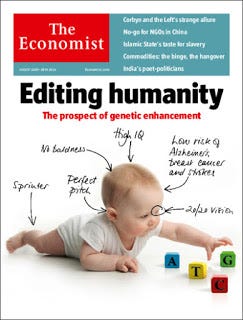Editing humanity

This is our cover story about CRISPR editing. My colleague Oliver Morton was instrumental in pulling the package together.
There is a leader (op-ed):
Genetic engineering
Editing humanity
A new technique for manipulating genes holds great promise—but rules are needed to govern its use
Aug 22nd 2015 | From the print edition
THE genome is written in an alphabet of just four letters. Being able to read, study and compare DNA sequences for humans, and thousands of other species, has become routine. A new technology promises to make it possible to edit genetic information quickly and cheaply. This could correct terrible genetic defects that blight lives. It also heralds the distant prospect of parents building their children to order.
The technology is known as CRISPR-Cas9, or just CRISPR. It involves a piece of RNA, a chemical messenger, designed to target a section of DNA; and an enzyme, called a nuclease, that can snip unwanted genes out and paste new ones in. Other ways of editing DNA exist, but CRISPR holds the promise of doing so with unprecedented simplicity, speed and precision. [More...]
A four page briefing:
Genome editing
The age of the red pen
It is now easy to edit the genomes of plants, animals and humans
Aug 22nd 2015 | From the print edition
IN THE summer of 2005 Karen Aiach and her husband received heartbreaking news about their four-month-old daughter, Ornella: she had a rare disorder known as Sanfilippo syndrome. The prognosis was that, from about the age of three, the disorder would gradually rob her of most of her cognitive abilities. She would probably develop a severe sleep disorder and become hyperactive and aggressive. She was unlikely to live into her teens; she certainly would not survive them.
The problem was that Ornella lacked a working copy of a specific gene. It is a gene that tells the body how to make a particular protein which is involved in clearing up cellular debris. Without that protein the cells of her body were unable to break down a complex sugar molecule, heparan sulphate. It is the build-up of that molecule in brain cells that lies behind the symptoms of the syndrome. If her cells could make that protein, the situation might, in principle, be reversed. Learning this, Ms Aiach embarked on a ten-year search for a way to correct the error in her daughter’s genome.
In almost every cell in Ornella’s body, as in every human body, there are two copies of the human genome, one from her mother, one from her father. In each of those genomes there are about 20,000 genes, each of which contains the recipe for a specific protein in the form of a sequence of chemical “letters”. To date, medicine has recognised about 6,000 diseases that can be traced to a problem with one or another of those genes—a disorder in which a missing or garbled sequence of DNA leaves the body unable to make a particular protein, or causes it to be made in an abnormal form. Some of these single-gene disorders are well known: Tay Sachs; sickle-cell anaemia; haemophilia. Others, such as Sanfilippo syndrome, are the sort of thing you learn of only when a child you care about turns out to be the one in 70,000 that it afflicts. [More...]
A podcast:
Babbage: August 19th 2015
Climate\'s wild child
A new technique makes editing the human genome much easier and this year\'s El Niño, a disrupting climate phenomenon, could be the strongest ever.



